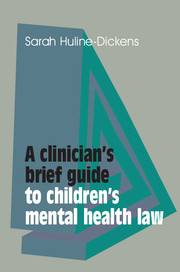Book contents
- Frontmatter
- Contents
- Foreword
- Acknowledgements
- List of cases
- Common abbreviations and terms
- 1 Introducing child mental health and the law
- 2 The rights of the child
- 3 The Children Act 1989 and the 2004 amendments
- 4 Consent to treatment
- 5 Confidentiality
- 6 The Mental Health Act
- 7 The Mental Capacity Act
- 8 Juvenile justice
- References
- Index
3 - The Children Act 1989 and the 2004 amendments
Published online by Cambridge University Press: 02 January 2018
- Frontmatter
- Contents
- Foreword
- Acknowledgements
- List of cases
- Common abbreviations and terms
- 1 Introducing child mental health and the law
- 2 The rights of the child
- 3 The Children Act 1989 and the 2004 amendments
- 4 Consent to treatment
- 5 Confidentiality
- 6 The Mental Health Act
- 7 The Mental Capacity Act
- 8 Juvenile justice
- References
- Index
Summary
The Children Act 1989 was intended to bring together various pieces of legislation about children and to assimilate private law with public law.
Phrases from the original 1989 Act such as a child in need, significant harm and the welfare checklist have become part of the lexicon of child and adolescent psychiatry. Safeguarding was a word not commonly in use until enshrined in amendments introduced by the Children Act 2004. Although the Children Act 2004 exists, it was an Act of amendment and the current legislation is the Children Act 1989 (as amended in 2004).
Clinicians will come into contact with the Act in several ways. Primarily they will need to know who has parental responsibility for a child or young person. Without knowing this, the basis of consent for any interventions is unclear. Knowledge of the Act is also necessary when encountering any forms of abuse in children. It becomes essential in dealing with difficult emergencies, for example knowing the social care responsibilities of local authorities and when a section 25 secure order might be indicated. In any services where children and young people with mental health problems also have particularly complex family situations (on in-patient units, for example), knowledge of the Act is important, and clinicians acting as professional or expert witnesses will also need a reasonable working knowledge of it.
It should be noted that, although children and young people up to the age of 18 can be detained using section 25 of the Children Act (see below), this does not authorise treatment. If the main purpose of the intervention is assessment and treatment, then it is more appropriate to use the Mental Health Act 1983 (see Chapter 6). If the child is behaviourally disturbed and the purpose is containment of the behaviour rather than assessment and treatment, then a secure order using section 25 of the Children Act may be more appropriate. Secure orders are discussed further in Chapter 8.
This chapter will not cover care and adoption proceedings, as these are beyond the scope of this book and are not specific to the field of children's mental health.
It is relevant to mention a few other pieces of legislation since the enactment of the Children Act 1989 and its amendments from 2004.
- Type
- Chapter
- Information
- Publisher: Royal College of PsychiatristsPrint publication year: 2016



